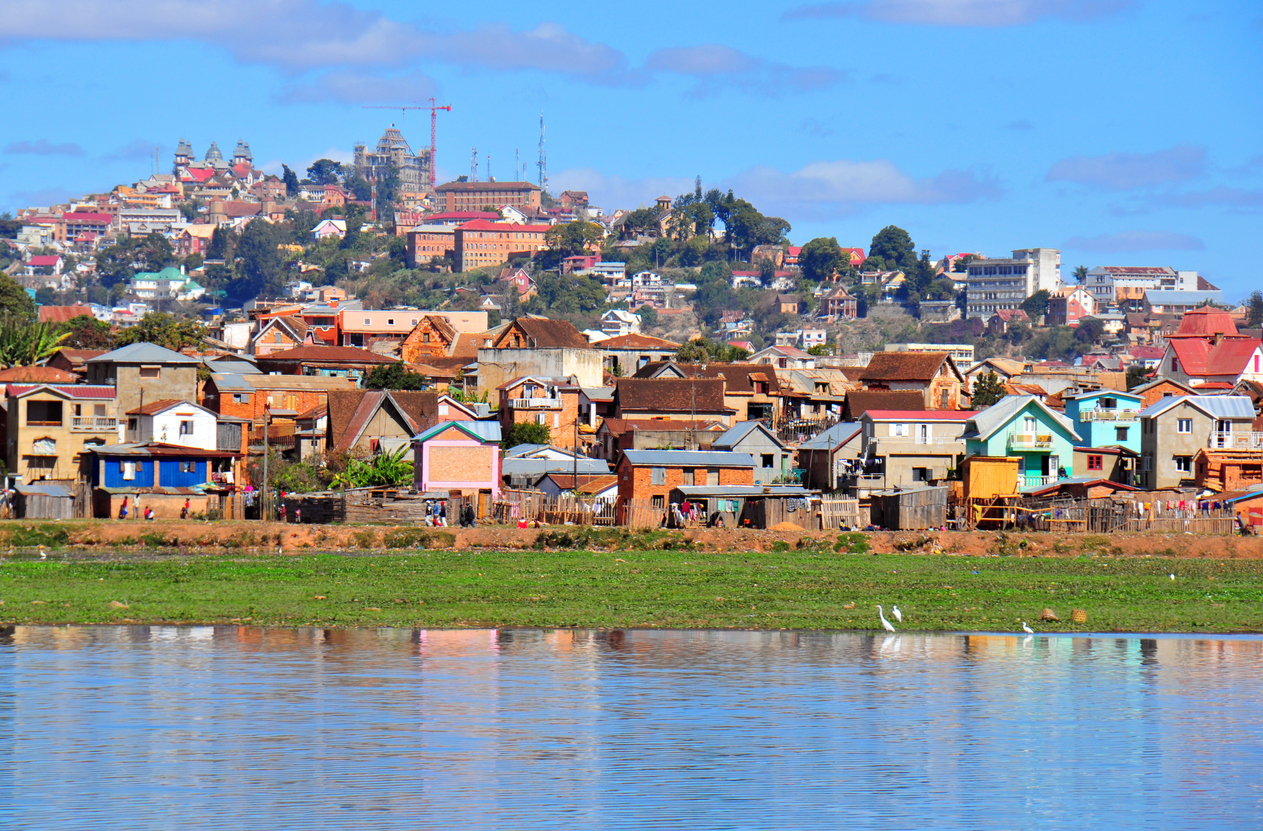Assessing Climate Risk for Resilience Planning: Five Lessons from African Cities
KEY INSIGHTS
- Despite the multiple climate vulnerabilities and risks in African cities, there remains a unique window of opportunity to get things right.
- Since 1990, the total number of African cities has doubled, and their cumulative population has increased by 500 million. Between now and 2050, African cities will house an additional 900 million residents.
- The Global Center on Adaptation (GCA) and its partners have developed the Rapid Climate Risk Assessment (RCRA) to identify achievable and effective urban solutions to reduce the human and economic toll of climate change impacts.
- The RCRA has so far been implemented in ten cities – Antananarivo (Madagascar), Bizerte (Tunisia), Conakry (Guinea), Dodoma (Tanzania), Libreville (Gabon), Djibouti City (Djibouti), Dakar (Senegal), Kisumu (Kenya), Mukuru (informal settlement in Nairobi, Kenya), and Marrakech (Morocco)
O
f the 100 fastest-growing cities in the world, 79 are in Africa. However, the provision of basic urban services has not kept pace with population growth – further complicated by climate change. Water supply, sewerage, and drainage infrastructures have not been designed to account for current climate events. Insufficient solid waste management exacerbates the occurrence of flooding.
As a result, many African cities are now considered extremely vulnerable to climate hazards. The majority of those affected are the poorest, living in informal settlements located in low-lying and coastal areas prone to flooding and sea level rise, built to low-quality standards with minimal green cover to protect from extreme heat and suffering from water scarcity on account of drought.
Understanding the current and future climate risk of a city through a Rapid Climate Risk Assessment (RCRA) can help identify, prioritize, and implement urban solutions and planning actions that prevent locking in errors made by other cities of the world. An RCRA gathers vital information on climate hazards and risks, infrastructure bottlenecks, past and current initiatives, and relevant policies and institutions. It identifies specific neighborhoods and districts that have recently experienced floods and other high-impact climate-related disasters.
Notably, the RCRA methodology has been designed specially to account for data-poor environments – a limitation commonly encountered in African contexts – by focusing on not just physical hazards but also institutional, infrastructural, and programmatic limitations. The social dimensions of vulnerability are also considered, specifically to understand the unique concerns of informal communities and other marginalized groups.
Climate adaptation investments should not be seen only as an expense. They make economic sense and often provide benefits more than five times the cost. Moving quickly to adapt is especially useful, with a benefit-cost ratio of at least 12 to 1. An RCRA can be the critical first step in a city’s long-term climate adaptation journey – something cities have already been embarking on as part of the Africa Adaptation Acceleration Program (AAAP).
The AAAP is an Africa-owned, Africa-led initiative launched by GCA and the African Development Bank to mobilize US$25 billion by 2025 for climate adaptation investments in Africa in the next five years. In its first two and a half years of operations, the AAAP Upstream Financing Facility has influenced downstream investments valued at more than US$6.9 billion in 28 African countries.
Below, we share five lessons from GCA’s experience implementing RCRAs in ten African cities as part of the AAAP, which offer insights for resilient city planning practices in developing country contexts.
1. Recognize the value of qualitative data.
To keep costs down and to promote time efficiency, the RCRA approach relies heavily on globally available free data – to gain a geographic understanding of a city’s climate risk. However, as many cities in the developing world tend to be data-poor, generating and utilizing qualitative data can be very effective in rounding out a more complete assessment. Information on local communities and institutions, as well as past and planned adaptation programs and projects, are valuable in understanding a city’s capacity to adapt and ability to cope and rebound in the event of a climate disaster. Qualitative data of this kind is invaluable.
2. Conducting RCRAs with a strong local government demand for investment significantly enables a well-informed assessment.
The success of an RCRA process depends heavily on a strong local champion who can help frame the local context and mobilize all key stakeholders. This is often the case when the local municipality sees a clear linkage between climate adaptation and development priorities. Before conducting an RCRA, time should be taken to ensure awareness is raised locally on how climate adaptation can serve as a strategic entry point for securing additional investment in development programs and infrastructure.
3. Consult and convene public investment decision-making entities early in the assessment process.
This helps ensure that the needs, incentives, and challenges faced in infrastructure development can be better reflected in actual investment. Securing the commitment of investment-focused entities, such as the local mayor’s office, municipal public works agencies, and sector ministries with direct experience in making capital investments, is crucial in ensuring that the outcomes of RCRAs translate into sustainable long-term results.
4. The informal sector represents a significant portion of African urban economies and must be understood to ensure practical climate adaptation activities.
Experience from the RCRA process has demonstrated the importance of identifying a local focal point (with deep knowledge of the local communities) early in the process. For example, an NGO or local social development consultant can help answer questions about the informal sector or make the contacts needed to gain this perspective – to ensure that the unique concerns of marginalized communities and the most vulnerable are understood in future identification, design, and implementation of climate adaptation investments.
5. Dedicate time and space for reflective learning and experience exchange.
Utilizing a dialogue and learning approach can help form collaborative linkages between city actors to address the multifaceted nature of new climate realities. The connections can be informal. However, as climate adaptation works across sectors and line budgets, establishing communication channels and coordination mechanisms between relevant stakeholders early in the process can enable successful climate adaptation down the road – especially when pooled resources and efforts are needed. This includes local communities who can play a strategic role in not only identifying risks but also as active participants in the construction, supervision, and long-term maintenance of climate adaptation interventions.

The RCRA Story of Antananarivo, Madagascar
Antananarivo is brimming at its edges – expanding uncontrollably into hazard-prone areas to accommodate the many millions seeking livelihood opportunities a city has to offer. Like many cities in Africa, this narrative is all too common: urban population growth and expansion have largely outpaced the capacity of existing infrastructure.
Against this backdrop, more frequent high-intensity rainfall events fueled by climate change, coupled with deforestation, have increased urban flood and landslide risk – especially of informal communities. And with the majority of the urban workforce employed in low-paying informal sector jobs, there is often little margin to cope with disruptions in urban service delivery.
This was all too apparent in January 2022, when the GCA RCRA process was underway and concurrently, two days of urban flooding tragically resulted in more than 30 dead, 6,800 houses under water and millions of dollars in economic damages and losses.
In the immediate aftermath of a disaster, a number of implementation challenges present themselves for an RCRA process. Public sector workers are often unavailable for interviews or information sharing, as many are deployed toward addressing the most pressing needs. Local communities are actively in the process of coping and are unable to offer insights. A sudden influx of development partners seeking to assist in the emergency response further leads to limited time available among stakeholders.
In such situations, it is important to be respectful of time and make a concerted effort to manage local expectations. The timeline for RCRA delivery may need to be extended beyond the emergency response phase (or at the least, the contingency to allow for such delays should be built into contracts). At the same time, the RCRA team must very clearly communicate that while an RCRA is meant to highlight a city’s climate vulnerabilities and needs, it does not guarantee investment. An RCRA can nevertheless be useful in adding the most up-to-date information on a city’s current climate reality – made very apparent in the immediate aftermaths of disaster.
Since completing the first five studies, the methodology has been fine-tuned, incorporating implementation experience. The refined approach has a better sequence interface, data sharing and coordination with local actors, and a structured process for follow-up investment discussions. These changes are reflected in the implementation of GCA’s RCRA methodology in a second batch of African cities as part of the AAAP: Dakar (Senegal), Marrakech (Morocco), Djibouti (Djibouti), Kisumu (Kenya), and Nairobi – focusing on Mukuru Informal Settlement (Kenya).
For more information on the RCRA methodology, read the City Resilience chapter of GCA’s 2022 State and Trends in Adaptation Report or listen to a recording of the Global Knowledge Exchange on Urban Climate Risk Assessments (available in English and French) organized by GCA’s Water and Adaptation Community.

Christopher Chung is GCA’s Senior Urban Specialist and co-author of the City Resilience chapter of GCA’s 2022 State and Trends in Adaptation Report. An urban planner by training, Mr. Chung has worked on integrating resilience into urban development, infrastructure, and housing projects in Africa, Latin America, and the Caribbean, as well as the Middle East and North Africa regions. He holds a Master’s in City Planning from the Massachusetts Institute of Technology (MIT). He has more than 17 years of experience working with international development organizations, including the World Bank and specialized UN agencies.

Joep Verhagen is GCA’s Program Lead, Water & Urban. In this role, Joep is leading a transformative program to mainstream climate adaptation in large-scale investment programs of the African Development Bank and World Bank with a combined investment value of more than US$1.5 billion. Currently, Joep is working in Bangladesh, Chad, Liberia, Ghana, Kenya, Sierra Leone, and Senegal, among others. Prior to joining GCA, he worked at the World Bank where he was co-leading the US$1.5 billion ‘Clean India Program’ and the US$100 million Rural Water Supply and Sanitation Improvement Project in Nepal.

Dr. Ede Ijjasz-Vasquez is the Senior Advisor, Africa at the Global Center on Adaptation, a non-resident Senior Fellow at the Brookings Institution, and and Senior Advisor to the Multilateral Center for Development Finance. Dr. Ijjasz worked for 23 years at the World Bank, where he was regional director for sustainable development and infrastructure for Africa, and Latin America, global senior director for the social, urban, rural, and resilience technical practice, and manager of the China sustainable development and infrastructure program. Dr. Ijjasz has a Ph.D. and an M.Sc. from the Massachusetts Institute of Technology (MIT). He has been a lecturer at the Environmental Science and Policy Program at the Johns Hopkins University, and at the Public Policy Program at Tsinghua University in Beijing.

Prof. Jamal Saghir is a Professor of Practice at the Institute for the Study of International Development at McGill University. He has over 25 years of experience at the World Bank Group directing departments related to energy and infrastructure, water, transport, agriculture and rural development, environment and climate change. A Senior Fellow at the Payne Institute at the Colorado School of Mines, and Distinguished Fellow for Economics and Development at the American University of Beirut, Prof. Saghir also serves as a Member of the Board of Directors for Cica SA; Satram-Huiles SA and FFA Private Bank. He is also Chair of the Advisory Committee of the Climate/SDGs Debt Swap Mechanism at UN-ESCWA; a member of the Advisory Board of the Middle East Water Forum; and a member of the Council, UN Sustainable Development Goal on Poverty Eradication, World Government Summit.